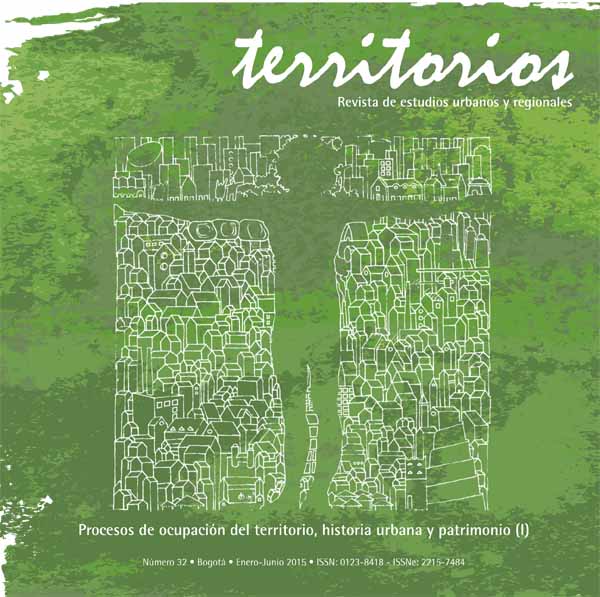Neoliberalización del territorio y movilidad urbana, una agenda de investigación
Barra lateral del artículo
Contenido principal del artículo
Descargas
Amin, A., & Malmberg, A. (1994). Competing Structural and Institutional Influences on the Geography of Production in Europe. En A. Amin (Ed.), Postfordism (pp. 227-248). Oxford: Blackwell.
Audirac, I. (2003). Information-Age. Landscapes Outside the Developed World. Journal of the american Planning Association, 69(1), 16-32.
Baeten, G. (2012). Neoliberal Planning. Does it Really Exist? In G. Baeten & T. Tasan-Kok (Eds.), Contradictions of Neoliberal Planning (pp. 205-213). London: Springer.
Bauman, Z. (2003). City of Fears, City of Hopes. London: Goldsmiths College. Bauman, Z. (2010). La globalización. Consecuencias humanas. México: Fondo de Cultura Económica.
Blomley, N. (2004). Unsettling the City. Urban Land and the Politics of Property. London: Routledge.
Bocarejo, J. P., Portilla, I., & Pérez, M. A. (2013). Impact of Transmilenio on density, land use and land value in Bogotá. Research in Transportation Economics, 40, 78-86.
Boltanski, L., & Chiapello, È. (2005). The New Spirit of Capitalism. London: Verso. Brenner, N. (2003). La formación de la ciudad global y el re-escalamiento del espacio del Estado en la Europa occidental
postfordista. EURE, Revista Latinoamericana de estudios urbanos regionales, 29(86), 5-35.
Brenner, N., & Theodore, N. (2005). Neoliberalism and the Urban Condition. City, 9(1), 101-107.
Brenner, N., Peck, J., & Theodore, N. (2010). After Neoliberalization? Globalizations, 7(3), 327-345.
Bridge, G., & Watson, S. (2003). City economies. En G. Bridge & S. Watson (Eds.), A Companion to the City (pp. 181-203). Oxford: Blackwell.
Cabrales, B. L. F. (2002). Latinoamérica. Países abiertos, ciudades cerradas. Guadalajara: Universidad de Guadalajara.
Cabrales, B. L. F. (2010). El de atrás paga: el modelo metropolitano de Guadalajara. En O. Urquídez (Coord.), La reinvención de la metrópoli. Algunas propuestas (pp.75-96). Zapopan: El Colegio de Jalisco.
Calonge, R. F. (2013). Los sentidos de la ciudad. Sobre cómo mujeres y hombres ordenan sus espacios vitales. Guadalajara: Universidad de Guadalajara.
Jacquin, C. (2012). Producir y habitar la periferia. Los nuevos conjuntos de vivienda de bajo costo en México. Bulletin de l’Institut Francaisd’ Estudes Andines, 41(3), 389-415.
Lindón, V. A. (1997). De la expansión urbana y la periferia metropolitana. México: El Colegio de México.
Lindón, V. A. (2006).Territorialidad y género. Una aproximación desde la subjetividad espacial. En M. A. Ramírez Kuri & P. Aguilar Díaz (Eds.), Pensar y habitar la ciudad. Afectividad, memoria y significado en el espacio urbano contemporáneo (pp. 13-32). Barcelona: Anthropos.
Lucas, K. (2004).Transport and social exclusion. En K. Lucas (Ed.), Running on Empty. Transport, Social Exclusion and Environmental Justice (pp. 39-54). Bristol: Policy Press.
Manderscheid, K. (2009). Unequal Mobilities. En T. Ohnmacht, H. Maksim M. M. & Bergman (Eds.), Mobilities and Inequality (pp. 27-50). Farnham: Ashgate.
Marcuse, P. (2003). Cities in Quarters. En G. Bridge & S. Watson (Eds.), A companion to the city (pp. 270-281). Oxford: Blackwell.
Mason, F. P. (2007). Watching the Traffic Go by. Transportation and Isolation in Urban America. Austin: University of Texas Press.
Massey, D. (2008). Ciudad Mundial. Caracas: Fundación Editorial el Perro y la Rana.
Merton, R. K. (2007). On Sociological Theories of the Middle Range. En Calhoun, Craig (Ed.), Classical sociological theory (pp. 448-459). Oxford: Blackwell.
Mitchell, K., & Beckett, K. (2008). Securing the Global City. Crime, Consulting, Risk and Ratings in the Production of Urban Space. Indiana Journal of Global Legal Studies, 15(1), 75-115.
Mulley, C., & Nelson, J. (2009). Flexible Transport Services. A new Market Oportunity for Public Transport. Research in Transportation Economics, 25(1), 39-45.
Ortiz, G. A., & Zetter, R. (2004). Market Enablement and Reconfiguration of Urban Structure in Colombia. En R. Zetter & M. Hamza (Eds.), Market Economy and Urban Change. Impactsin the Developing World (pp. 185-204). London: Earhtscan.
Peck, J. T. N., & Brenner, N. (2009). Neoliberal Urbanism. Models, Moments, Mutations. SAIS Review, XXXIX(1), 49-66.
Redshaw, S. (2008). In the Company of Cars. Driving as a Social and Cultural Practice. Aldershot: Ashgate.
Rodgers, D. B. J., & Kanbur, R. (2011). Latin American Urban Development into the Twenty-first Century: Towards a Renewed Perspective of the City. European Journal of Development Research,
(4), 550-568.
Sánchez, P. G. A. (2011). Incidencia del aeropuerto Eldorado en la estructura espacial de la ciudad de Bogotá, período 1990-2010. Perspectiva Geográfica, 16, 173-196.
Sassen, S. (2000). Cities in a World Economy. London: Pine Forge Press.
Sibley, D. (1995). Geographies of Exclusion. Society and Difference in the West. London: Routledge.
Sohn, H. (2011). Denationalization. The Subjugation of México and its Capital City. En T. Kaminer, M. Robles Durán & H. Sohn (Eds.), Urban Asymmetries. Studies and Projects on Neoliberal Urbanization
(pp. 64-83). Rotterdam: 010 Publishers.
Soja, E. W. (1990). Postmodern Geographies. The Reassertion of Space in Critical Social Theory. London: Verso.
Soja, E. W. (2000). Postmetropolis. Critical Studies of Cities and Regions. Oxford: Blackwell.
Soja, E. W. (2003). Writing the City Spatially. City, 7(3), 269-280.
Swyngedouw, E. (2004). Globalisation or ‘Glocalisation’? Networks, Territories and Rescaling. Cambridge Review of International Affairs, 17(1), 25-48.
Vázquez, C. M. T. (2004). Land privatization in México: Urbanization, Formation of Regions and Globalization in Ejidos. New York: Routledge.
Wolfe, J. (2010). Autos and Progress. The Brazilian Search for Modernity. Oxford: Oxford University Press.
Zetter, R. (2004). Market Enablement and the Urban Sector. En R. Zetter & M. Hamza (Eds.), Market Economy and Urban Change. Impacts in the Developing World (pp. 1-40). London: Earhtscan.
Zhang, M., & Wang, L. (2013). The impacts of mass transit on land development in China. The case of Beijing. Research in Transportation Economics, 40, 124-133.
Detalles del artículo
Los autores conservan los derechos de autor y garantizan a la revista el derecho de ser la primera publicación del trabajo al igual que licenciado bajo una Creative Commons Attribution License que permite a otros compartir el trabajo con un reconocimiento de la autoría del trabajo y la publicación inicial en esta revista.
La revista no cobra cargos por publicar a los autores por el proceso de edición de los artículos.
Artículos más leídos del mismo autor/a
- Fernando Calonge Reillo, Tener coche y no usarlo en México. Una ventana abierta a la sustentabilidad urbana , Territorios: Núm. 50 (2024): Miscelánea



